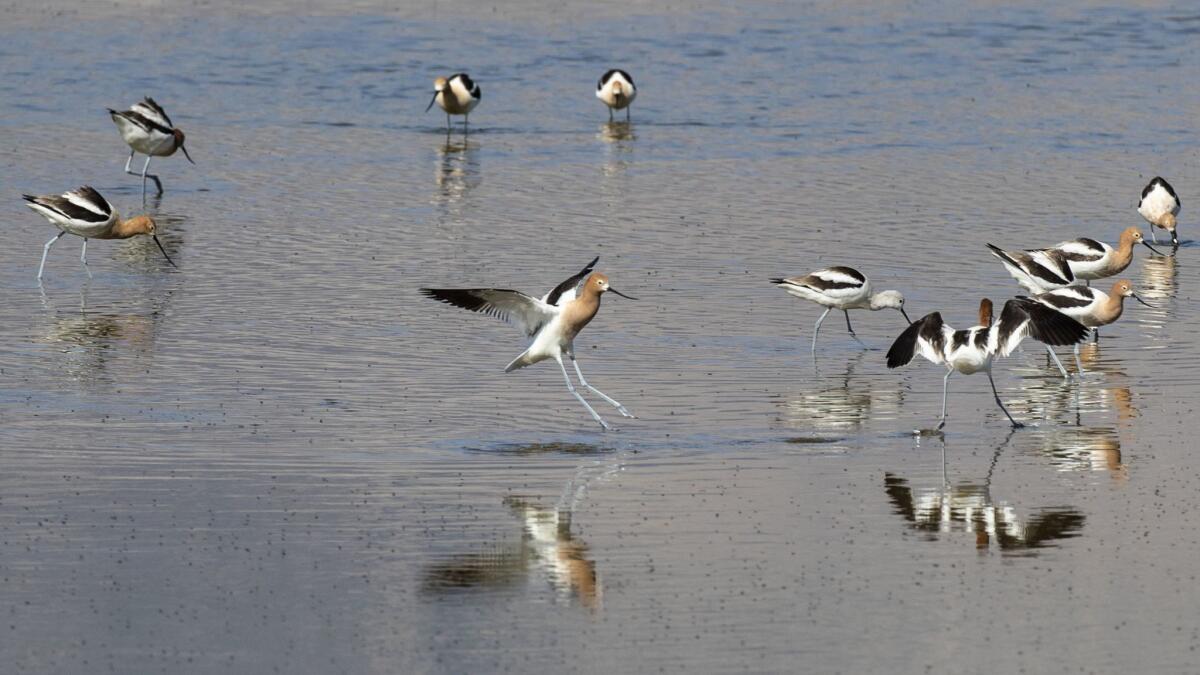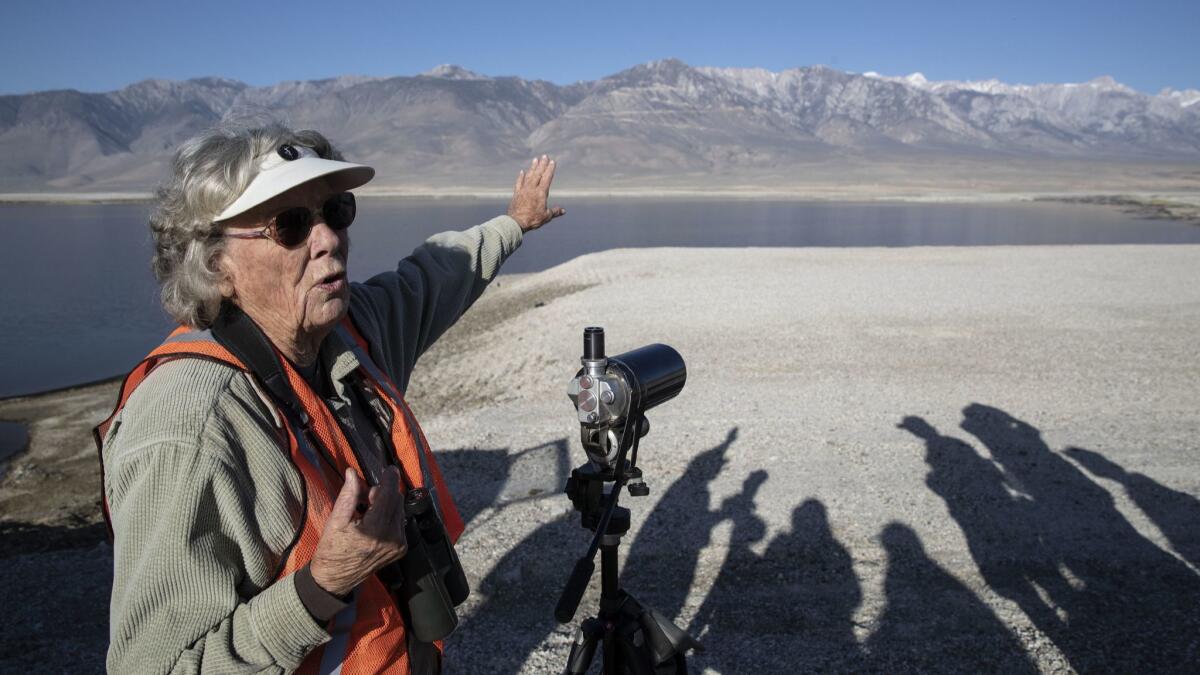Owens Lake: Former toxic dust bowl transformed into environmental success

- Share via
Reporting from Lone Pine, Calif. — Fearsome gusts of desert wind routinely kicked up swirling clouds of choking dust over Owens Lake on the east side of the Sierra Nevada after 1913, when its treasured snowmelt and spring water was first diverted into the Los Angeles Aqueduct.
It was not until 2001, and under a court order, that the Los Angeles Department of Water and Power began transforming the lake’s grim heritage, flooding portions where toxic, powder-fine dust exceeded federal pollution standards.
In what is now hailed as an astonishing environmental success, nature quickly responded. First to appear on the thin sheen of water tinged bright green, red and orange by algae and bacteria were brine flies. Then came masses of waterfowl and shorebirds that feed on the insects.
On Saturday, Owens Lake was designated a Western Hemisphere Shorebird Reserve Network site of international importance, joining an exclusive group of 104 areas between Alaska and the southern end of South America certified for their outstanding numbers of birds.
Saturday’s designation is part of a growing movement across the nation and around the world that sees wetlands as crucial connections to natural vistas that are receding as the planet heats up and development spreads.
Rob Clay, director of the shorebird reserve network headquartered in Plymouth, Mass., said it is also testament to a Los Angeles dust mitigation project that “demonstrates how human welfare and biodiversity conservation are intrinsically linked.”
The designation coincided with the fourth annual Owens Lake Bird Festival, which is co-hosted by the LADWP and many of the conservationists who played a large role in holding L.A. accountable for massive dust storms that have besieged the Inyo County territory of striking geographic contrasts where 14,000-foot Sierra Nevada peaks and the Mojave Desert intersect.
On Saturday morning, hundreds of festival attendants led by tour guides crisscrossed the lake’s crunchy white shoreline to experience one of the most spectacular avian shows nature has to offer in California.

Among them were Tom and Jo Heindel, of the nearby community of Big Pine, who are nearing completion of a comprehensive scientific survey of every species and subspecies of bird ever documented in Inyo County over the last 150 years.
“When we moved to Owens Valley in 1972, there were only a few wet spots on the lake bed,” Jo, 79, recalled. “Now, it’s a whole new world.”
Across the 100-square-mile lake bed, an estimated 60,000 shorebirds and waders — long-billed curlews, sandpipers, dowitchers, whimbrels, American avocets, black-necked stilts, yellowlegs, cinnamon teals and eared grebes with golden feathers fanning out behind their eyes — were gorging on brine flies to bulk up fat reserves needed to complete migratory journeys to breeding areas in the boreal forests of Alaska, Canada and the Arctic.
Hundreds of rare western snowy plovers are drawn to the lake to nest in the summer.
The shorebird reserve network, which designates at one of three levels — hemispheric, international and regional, depending on the scale of the avian populations of a nominated site — voted unanimously to give Owens Lake international status.
Winning the designation represents nearly a decade of hard work by environmental activists, including Owens Valley botanist Michael Prather, who helped organize the bird festival, and LADWP engineers and biologists.
“Los Angeles’ efforts to improve the Owens Lake environment are praiseworthy,” Prather said. “We believe there are more birds at the lake now than at any time since Joseph Grinnell of UC Berkeley’s Museum of Natural History visited the area a century ago.
“Of course,” he added, “we still have our differences with the LADWP elsewhere in Owens Valley.”
Water wars have raged over Owens Valley since the early 1900s, when the city of Los Angeles had agents pose as farmers and ranchers to buy land and water rights in the area, then began building the aqueduct to slake the thirst of the growing metropolis about 200 miles to the south. L.A. diverted so much water via the aqueduct system that it was nearly impossible for local farmers and ranchers to make a living — a scandal dramatized in the classic 1974 film “Chinatown.”
The LADWP has spent about $2 billion in accordance with a 1997 agreement to combat dust from targeted areas of the dry lake bed. By introducing vegetation, gravel and shallow flooding, the agency has reduced particle air pollution by more than 95%.
“We’re extremely proud to be in a partnership with Audubon and other groups that worked hand in hand to get to this point,” Marty Adams, chief operating officer for the DWP, said in an interview. “We’ve created one of the largest projects in the world based on natural solutions for quality-of-life issues.”
Jo Heindel was only half-kidding when she suggested that “Los Angeles would face one heck of a legal fight if it ever decided to stop flooding this lake bed.”
“Our side is better organized and has a lot more people than ever,” she said. “Adding strength to our cause: Owens Lake is now a designated international hot spot for shorebirds.”
More to Read
Sign up for Essential California
The most important California stories and recommendations in your inbox every morning.
You may occasionally receive promotional content from the Los Angeles Times.














